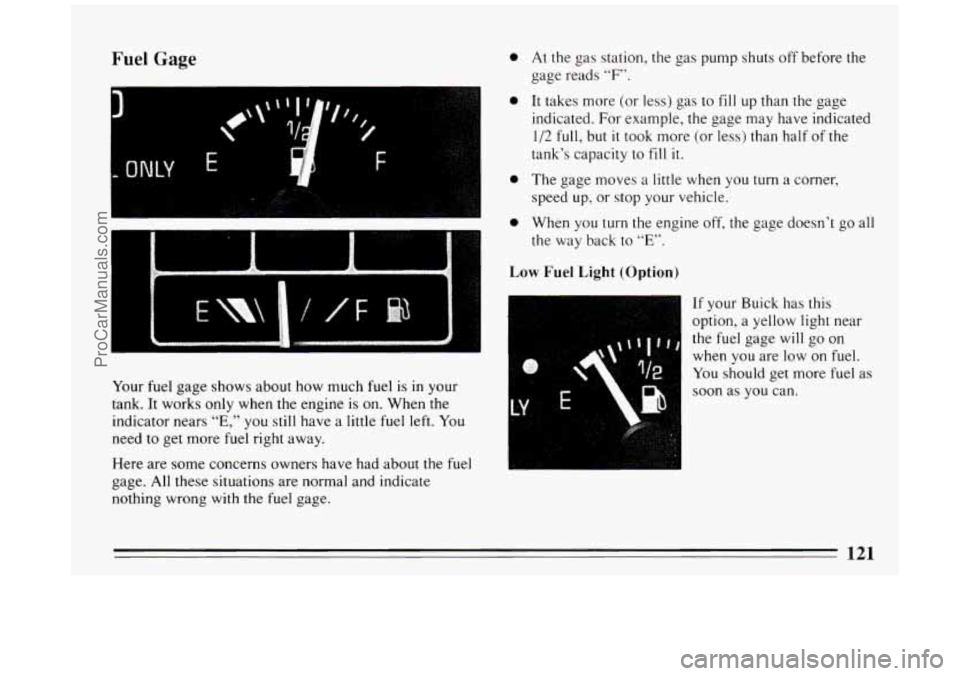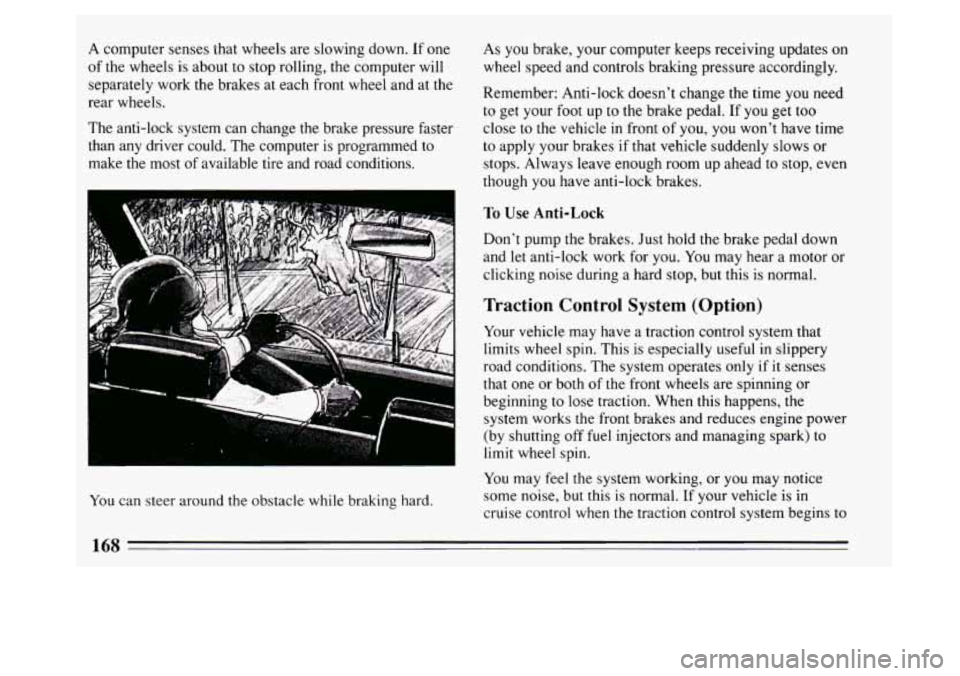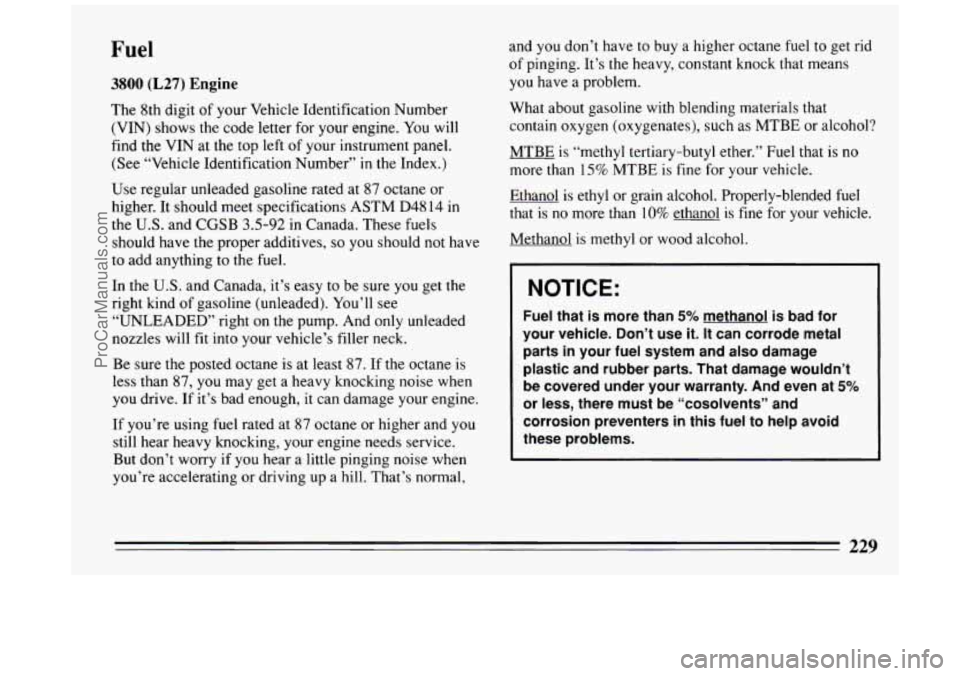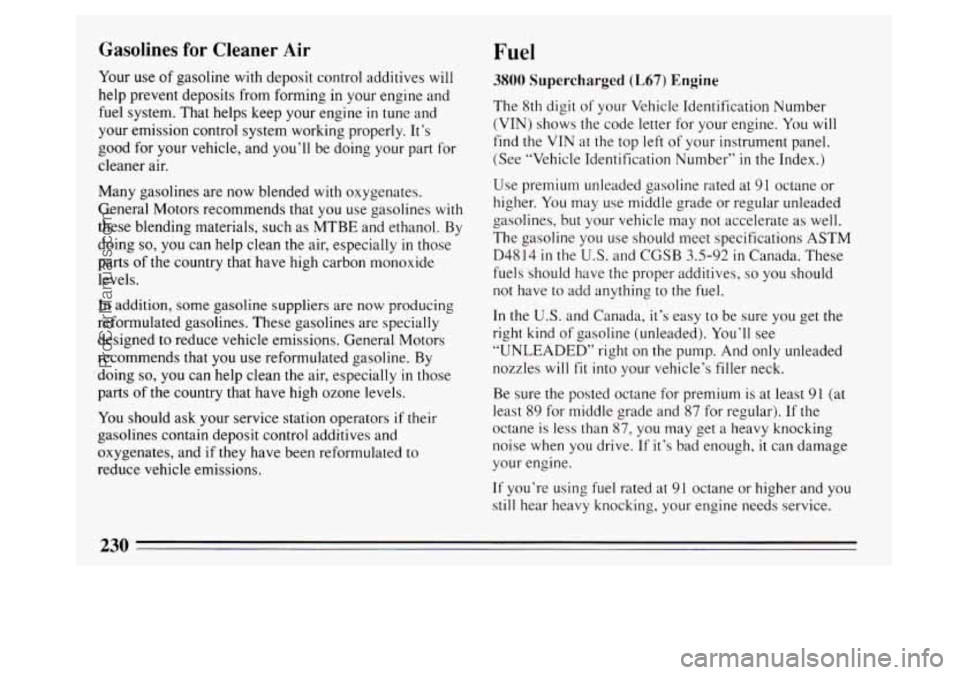1994 BUICK PARK AVENUE fuel pump
[x] Cancel search: fuel pumpPage 123 of 324

Fuel Gage
Your fuel gage shows about how much fuel is in your
tank. It works only when the engine is on. When the
indicator nears
“E,” you still have a little fuel left. You
need to get more fuel right away.
Here are some concerns owners have had about
the fuel
gage. All these situations are normal and indicate
nothing wrong with the fuel gage.
0
0
0
0
At the gas station, the gas pump shuts off before the
gage reads
“F’.
It takes more (or less) gas to fill up than the gage
indicated.
For example, the gage may have indicated
1/2 full, but it took more (or less) than half of the
tank’s capacity to
fill it.
The gage moves a little when you turn a corner,
speed up, or stop your vehicle.
When you turn the engine off, the gage doesn’t go all
the way back to
“E”.
Low Fuel Light (Option)
If your Buick has this
option, a yellow light near
the fuel gage will
go on
when
you are low on fuel.
You should get more fuel as
soon as
you can.
121
ProCarManuals.com
Page 170 of 324

A computer senses that wheels are slowing down. If one
of the wheels is about to stop rolling, the computer will
separately work the brakes at each front wheel and at the
rear wheels.
The anti-lock system can change the brake pressure faster
than any driver could. The computer is programmed to
make the most of available tire and road conditions.
m
b r
You can steer around the obstacle while braking hard. As you
brake, your computer keeps receiving updates on
wheel speed and controls braking pressure accordingly.
Remember: Anti-lock doesn’t change the time you need
to get your foot up to the brake pedal. If you get too
close to the vehicle in front of you, you won’t have time
to apply your brakes if that vehicle suddenly slows or
stops. Always leave enough room up ahead to stop, even
though you have anti-lock brakes.
To Use Anti-Lock
Don’t pump the brakes. Just hold the brake pedal down
and let anti-lock work for you.
You may hear a motor or
clicking noise during a hard stop, but this is normal.
Traction Control System (Option)
Your vehicle may have a traction control system that
limits wheel spin. This is especially useful in slippery
road conditions. The system operates only
if it senses
that one or both of the front wheels are spinning or
beginning to lose traction. When
this happens, the
system works the front brakes and reduces engine power
(by shutting off fuel injectors and managing spark) to
limit wheel spin.
You may feel the system working, or you may notice
some noise, but this
is normal. If your vehicle is in
cruise control when the traction control system begins to
168
ProCarManuals.com
Page 231 of 324

Fuel
3800 (L27) Engine
The 8th digit of your Vehicle Identification Number
(VIN) shows the code letter for
your engine. You will
find the VIN at the top left of your instrument panel.
(See “Vehicle Identification Number’’ in the Index.)
Use regular unleaded gasoline rated at 87 octane or
higher. It should meet specifications ASTM D48
14 in
the
U.S. and CGSB 3.5-92 in Canada. These fuels
should have the proper additives,
so you should not have
to add anything to the fuel.
In the
U.S. and Canada, it’s easy to be sure you get the
right kind
of gasoline (unleaded). You’ll see
“UNLEADED” right
on the pump. And only unleaded
nozzles will fit into your vehicle’s filler neck.
Be sure the posted octane is at least 87.
If the octane is
less than 87,
you may get a heavy knocking noise when
you drive. If it’s bad enough, it can damage your engine.
If you’re using fuel rated at 87 octane or higher and
you
still hear heavy knocking, your engine needs service.
But don’t worry if you hear a little pinging noise when
you’re accelerating or driving up a hill. That’s normal, and
you don’t have to buy a higher octane
fuel to get rid
of pinging. It’s the heavy, constant knock that means
you have a problem.
What about gasoline with blending materials that
contain oxygen (oxygenates), such
as MTBE or alcohol?
MTBE is “methyl tertiary-butyl ether.” Fuel that
is no
more than
15% MTBE is fine for your vehicle.
Ethanol is ethyl or grain alcohol. Properly-blended
fuel
that is no more than 10% ethanol is fine for your vehicle.
Methanol is methyl or wood alcohol.
NOTICE:
Fuel that is more than 5% methanol is bad for
your vehicle. Don’t use it. It can corrode metal
parts in your fuel system and also damage
plastic and rubber parts. That damage wouldn’t
be covered under your warranty. And even at
5%
or less, there must be “cosolvents” and
corrosion preventers in this fuel to help avoid
these problems.
229
ProCarManuals.com
Page 232 of 324

Gasolines for Cleaner Air
Your use of gasoline with deposit control additives will
help prevent deposits from forming
in your engine and
fuel system. That helps keep your engine
in tune and
your emission control system working properly. It’s
good for your vehicle, and you’ll be doing your part for
cleaner air.
Many gasolines are now blended with oxygenates.
General Motors recommends that you use gasolines
with
these blending materials, such as MTBE and ethanol. By
doing
so, you can help clean the air, especially in those
parts
of the country that have high carbon monoxide
levels.
In addition, some gasoline suppliers are now producing
reformulated gasolines. These gasolines are specially
designed to reduce vehicle emissions. General Motors
recommends that you use reformulated gasoline. By
doing
so, you can help clean the air, especially in those
parts of the country that have high ozone levels.
You should ask your service station operators
if their
gasolines contain deposit control additives and
oxygenates, and if they have been reformulated to
reduce vehicle emissions.
Fuel
3800 Supercharged (L67) Engine
The 8th digit of your Vehicle Identification Number
(VIN) shows the code letter for your engine. You will
find the VIN at the top left of your instrument panel.
(See “Vehicle Identification Number”
in the Index.)
Use premium unleaded gasoline rated at 91 octane or
higher.
You may use middle grade or regular unleaded
gasolines, but your vehicle may not accelerate as well.
The gasoline you use should meet specifications ASTM
D48 14 in the U.S. and CGSB 3.5-92 in Canada. These
fuels should have the proper additives,
so you should
not have to add anything to the fuel.
In the U.S. and Canada, it’s easy to be sure you get the
right kind of gasoline (unleaded). You’ll see
“UNLEADED” right on the pump. And only unleaded
nozzles
will fit into your vehicle’s’filler neck.
Be sure the posted octane for premium is at least 91 (at
least 89 for middle grade and 87 for regular). If the
octane is less than 87, you may get a heavy knocking
noise when you drive. If it’s bad enough,
it can damage
your engine.
If you’re using fuel rated at 91 octane or higher and you
still hear heavy knocking, your engine needs service.
230
ProCarManuals.com
Page 239 of 324

3800 Supercharged (L67) Engine
(Option)
Your Park Avenue Ultra has a 3800 Supercharged
engine. Buick chose supercharging rather than
turbocharging because Buick emphasizes smooth,
refined power.
The Supercharger is a device which is designed to pump
more air into the engine than it would normally use.
This air mixed with fuel, creates increased engine
power. Since
the Supercharger is a pump and is driven
from an engine accessory drive belt, increased pressure
is available at all driving conditions.
The powertrain control module (PCM), works with a
vacuum control to regulate the increased pressure
required during specific driving conditions. When this
increased pressure or boost is not desired, such as during
idling and light throttle cruising, the excess air that the
Supercharger is pumping
is routed through a bypass. All
of these controls, working together provide high
performance character and
fuel efficiency in the 3800
V6 Supercharged Buick engine.
The power steering pump uses a remote reservoir
mounted on the throttle and cruise control cable bracket.
See “Maintenance Schedule’’ in
the Index for when you
should check the fluid.
Engine Accessory Belt
The Supercharged 3800 engine uses two accessory drive
belts. One belt drives the generator and the power
steering pump. The second belt drives the supercharger,
coolant pump and air conditioning compressor. Each
belt has its own tensioner and idler pulley.
1. Front Belt
C. Crank
2. Back belt D. Supercharger
A. Generator
E. Coolant Pump
B. Power Steering Pump E Air Conditioning
237
ProCarManuals.com